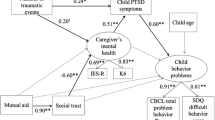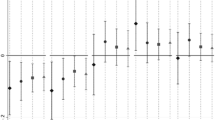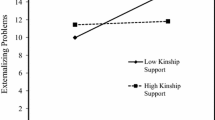Abstract
Purpose
The purpose of this study was to investigate the association between community-level social capital and physical abuse towards children, and the mediating effect of parental psychological distress by multilevel mediation analyses.
Methods
We analyzed data from a population-based study of first-grade elementary school children (6–7 years old) in Adachi City, Tokyo, Japan. The caregivers of first-grade students from all elementary schools in Adachi City (N = 5355) were asked to respond to a questionnaire assessing parents’ self-reported physical abuse (beating and hitting) and neighborhood social capital. Among them, 4291 parents returned valid responses (response rate 80.1%). We performed multilevel analyses to determine the relationships between community-level parental social capital and physical abuse, and further multilevel mediation analyses were performed to determine whether parental psychological distress mediated the association.
Results
Low community-level social capital was positively associated with physical abuse (both beating and hitting) after adjustment for other individual covariates (beating: middle, OR = 1.54, 95% CI 1.11–2.13; low, OR = 1.33, 95% CI 0.94–1.88; and hitting: middle, OR = 1.35, 95% CI 1.02–1.80; low, OR = 1.16, 95% CI 0.86–1.57). Multilevel mediation analyses revealed that community-level parental psychological distress did not mediate the association (indirect effect ß = 0.10, 95% CI − 0.10 to 0.29, p = 0.34 for beating; ß = 0.03, 95% CI − 0.16 to 0.23, p = 0.74 for hitting).
Conclusions
Fostering community-level social capital might be important for developing a strategy to prevent child maltreatment, which may have a direct impact on abusive behavior towards children.

Similar content being viewed by others
References
World Health Organization (WHO) (2016) Fact sheet: child maltreatment. http://www.who.int/mediacentre/factsheets/fs150/en/. Accessed 7 Mar 2017
Freisthler B, Merritt DH, LaScala EA (2006) Understanding the ecology of child maltreatment: a review of the literature and directions for future research. Child Maltreat 11(3):263–280. https://doi.org/10.1177/1077559506289524
Bronfenbrenner U (2009) The ecology of human development. Harvard University Press, Cambridge
Belsky J (1980) Child Maltreatment: an ecological integration. Am Psychol 35:320–335
Coulton CJ, Crampton DS, Irwin M, Spilsbury JC, Korbin JE (2007) How neighborhoods influence child maltreatment: a review of the literature and alternative pathways. Child Abuse Neglect 31:1117–1142
Maguire-Jack K (2014) Multilevel Investigation into the Community Context of Child Maltreatment. J Aggress Maltreatment Trauma 23:229–248
Institute of Medicine and National Research Council (2014) New directions in child abuse and neglect research. The National Academies Press, Washington, DC
Freisthler B, Maguire-Jack K (2015) Understanding the interplay between neighborhood structural factors, social processes, and alcohol outlets on child physical abuse. Child Maltreat 20(4):268–277. https://doi.org/10.1177/1077559515598000
Garbarino J, Kostelny K (1992) Child maltreatment as a community problem. Child Abuse Neglect 16:455–464
Coulton CJ, Korbin JE, Su M, Chow J (1995) Community level factors and child maltreatment rates. Child Dev 66:1262–1276
Drake B, Pandey S (1996) Understanding the relationship between neighborhood poverty and specific types of child maltreatment. Child Abuse Neglect 20:1003–1018
Korbin JE, Coulton CJ, Chard S, Platt-Houston C, Su M (1998) Impoverishment and child maltreatment in African American and European American neighborhoods. Dev Psychopathol 10:215–233
Coulton CJ, Korbin JE, Su M (1999) Neighborhoods and child maltreatment: a multi-level study. Child Abuse Negl 23:1019–1040
Korbin JE, Coulton CJ, Lindstrom-Ufuti H, Spilsbury J (2000) Neighborhood views on the definition and etiology of child maltreatment. Child Abuse Negl 24:1509–1527
Ernst JS (2001) Community-level factors and child maltreatment in a suburban county. Soc Work Res 25:133–142
Merritt DH (2009) Child abuse potential: correlates with child maltreatment rates and structural measures of neighborhoods. Child Youth Serv Rev 31(8):927–934. https://doi.org/10.1016/j.childyouth.2009.04.009
Molnar BE, Buka SL, Brennan RT, Holton JK, Earls F (2003) A multilevel study of neighborhoods and parent-to-child physical aggression: results from the project on human development in Chicago neighborhoods. Child Maltreat 8(2):84–97. https://doi.org/10.1177/1077559502250822
Molnar BE, Goerge RM, Gilsanz P, Hill A, Subramanian SV, Holton JK, Duncan DT, Beatriz ED, Beardslee WR (2016) Neighborhood-level social processes and substantiated cases of child maltreatment. Child Abuse Negl 51:41–53. https://doi.org/10.1016/j.chiabu.2015.11.007
Fujiwara T, Yamaoka Y, Kawachi I (2016) Neighborhood social capital and infant physical abuse: a population-based study in Japan. Int J Mental Health Syst 10:13
Coleman JS (1990) Foundations of social theory. Belknap Press of Harvard University Press, Cambridge
Kawachi I, Subramanian SV, Kim D (2008) Social capital and health. Springer, New York
Carlson ED, Chamberlain RM (2003) Social capital, health, and health disparities. J Nurs Scholarsh 35(4):325–331
Kawachi I (2006) Commentary: social capital and health: making the connections one step at a time. Int J Epidemiol 35(4):989–993. https://doi.org/10.1093/ije/dyl117
Kawachi I, Subramanian SV (2006) Measuring and modeling the social and geographic context of trauma: a multilevel modeling approach. J Trauma Stress 19(2):195–203. https://doi.org/10.1002/jts.20108
Maguire-Jack K, Showalter K (2016) The protective effect of neighborhood social cohesion in child abuse and neglect. Child Abuse Negl 52:29–37. https://doi.org/10.1016/j.chiabu.2015.12.011
Garbarino J, Sherman D (1980) High-risk neighborhoods and high-risk families: the human ecology of child maltreatment. Child Dev 51:188–198
Ono M, Honda S (2017) Association between social support and child abuse potential among Japanese mothers. Child Youth Serv Rev 73:88–92
Maguire-Jack K, Wang X (2016) Pathways from neighborhood to neglect: the mediating effects of social support and parenting stress. Child Youth Serv Rev 66:28–34
Guterman NB, Lee SJ, Taylor CA, Rathouz PJ (2009) Parental perceptions of neighborhood processes, stress, personal control, and risk for physical child abuse and neglect. Child Abuse Neglect 33:897–906
Zolotor AJ, Runyan DK (2006) Social capital, family violence, and neglect. Pediatrics 117(6):e1124–e1131. https://doi.org/10.1542/peds.2005-1913
Vinson T, Baldry E, Hargreaves J (1996) Neighbourhoods, networks and child abuse. Br J Soc Work 26:523–543
Kim B, Maguire-Jack K (2015) Community interaction and child maltreatment. Child Abuse Negl 41:146–157
Barnhart S, Maguire-Jack K (2016) Single mothers in their communities: the mediating role of parenting stress and depression between social cohesion, social control and child maltreatment. Child Youth Serv Rev 70:37–45. https://doi.org/10.1016/j.childyouth.2016.09.003
Adachi City (2016) https://www.city.adachi.tokyo.jp/sesaku/documents/miraihetunaguadachiproject.pdf. Accessed 23 May 2018 (in Japanese)
Zhang Z, Zyphur MJ, Preacher KJ (2009) Testing multilevel mediation using hierarchical linear models. Organ Res Methods 12(4):695–719. https://doi.org/10.1177/1094428108327450
Fujiwara T, Kasahara M, Tsujii H, Okuyama M (2014) Association of maternal developmental disorder traits with child mistreatment: a prospective study in Japan. Child Abuse Negl 38(8):1283–1289. https://doi.org/10.1016/j.chiabu.2014.04.007
Tokunaga M, Ohara M, Kayama M, Yoshimura K, Mitsuhashi J, Senoo E (2000) Survey of child maltreatment among general population in Greater Tokyo. Kosei No Shihyo 47(15):3–10
Jung M, Lin L, Viswanath K (2013) Associations between health communication behaviors, neighborhood social capital, vaccine knowledge, and parents’ H1N1 vaccination of their children. Vaccine 31(42):4860–4866. https://doi.org/10.1016/j.vaccine.2013.07.068
Sampson RJ, Raudenbush SW, Earls F (1997) Neighborhoods and violent crime: a multilevel study of collective efficacy. Science 277(5328):918–924
Saito M, Kondo N, Aida J, Kawachi I, Koyama S, Ojima T, Kondo K (2017) Development of an instrument for community-level health related social capital among Japanese older people: the JAGES project. J Epidemiol 27(5):221–227. https://doi.org/10.1016/j.je.2016.06.005
Fujiwara T, Takamoto I, Amemiya A, Hanazato M, Suzuki N, Nagamine Y, Sasaki Y, Tani Y, Yazawa A, Inoue Y, Shirai K, Shobugawa Y, Kondo N, Kondo K (2017) Is a hilly neighborhood environment associated with diabetes mellitus among older people? Results from the JAGES 2010 study. Soc Sci Med 182:45–51. https://doi.org/10.1016/j.socscimed.2017.04.008
Miyamoto K, Iwakuma M, Nakayama T (2015) Social capital and health: implication for health promotion by lay citizens in Japan. Glob Health Promot 22(4):5–19. https://doi.org/10.1177/1757975914547547
Aida J, Hanibuchi T, Nakade M, Hirai H, Osaka K, Kondo K (2009) The different effects of vertical social capital and horizontal social capital on dental status: a multilevel analysis. Soc Sci Med 69(4):512–518. https://doi.org/10.1016/j.socscimed.2009.06.003
Townsend P (1979) Poverty in the United Kingdom. Allen Lane and Penguin Books, London
Nolan B, Whelan CT (2010) Using non-monetary deprivation indicators to analyze poverty and social exclusion: lessons from Europe? J Pol Anal Manag 29(2):305–325
Ministry of Health, Labour and Welfare, Japan. Comprehensive Survey of Living Conditions (2016) http://www.mhlw.go.jp/toukei/saikin/hw/k-tyosa/k-tyosa16/index.html. Accessed 21 May 2018 (in Japanese)
Ehsan AM, De Silva MJ (2015) Social capital and common mental disorder: a systematic review. J Epidemiol Community Health 69(10):1021–1028. https://doi.org/10.1136/jech-2015-205868
Stith SM, Liu T, Davies LC, Boykin EL, Alder MC, Harris JM, Som A, McPherson M, Dees JEMEG. (2009) Risk factors in child maltreatment: a meta-analytic review of the literature. Aggress Violent Beh 14(1):13–29. https://doi.org/10.1016/j.avb.2006.03.006
Kessler RC, Barker PR, Colpe LJ, Epstein JF, Gfroerer JC, Hiripi E, Howes MJ, Normand SL, Manderscheid RW, Walters EE, Zaslavsky AM (2003) Screening for serious mental illness in the general population. Arch Gen Psychiatry 60:184–189
Furukawa TA, Kawakami N, Saitoh M, Ono Y, Nakane Y, Nakamura Y, Tachimori H, Iwata N, Uda H, Nakane H, Watanabe M, Naganuma Y, Hata Y, Kobayashi M, Miyake Y, Takeshima T, Kikkawa T (2008) The performance of the Japanese version of the K6 and K10 in the World Mental Health Survey Japan. Int J Methods Psychiatr Res 17(3):152–158. https://doi.org/10.1002/mpr.257
Muthén LK, Muthén BO (1998–2017) Mplus user’s guide. 8th Ed. Muthén & Muthén, Los Angeles
Sun X, Rehnberg C, Meng Q (2009) How are individual-level social capital and poverty associated with health equity? A study from two Chinese cities. Int J Equity Health 8:2. https://doi.org/10.1186/1475-9276-8-2
Stafford M, De Silva M, Stansfeld S, Marmot M (2008) Neighbourhood social capital and common mental disorder: testing the link in a general population sample. Health Place 14(3):394–405. https://doi.org/10.1016/j.healthplace.2007.08.006
Uphoff EP, Pickett KE, Cabieses B, Small N, Wright J (2013) A systematic review of the relationships between social capital and socioeconomic inequalities in health: a contribution to understanding the psychosocial pathway of health inequalities. Int J Equity Health 12:54. https://doi.org/10.1186/1475-9276-12-54
Iwase T, Suzuki E, Fujiwara T, Takao S, Doi H, Kawachi I (2012) Do bonding and bridging social capital have differential effects on self-rated health? A community based study in Japan. J Epidemiol Community Health 66(6):557–562. https://doi.org/10.1136/jech.2010.115592
Murayama H, Nishi M, Matsuo E, Nofuji Y, Shimizu Y, Taniguchi Y, Fujiwara Y, Shinkai S (2013) Do bonding and bridging social capital affect self-rated health, depressive mood and cognitive decline in older Japanese? A prospective cohort study. Soc Sci Med 98:247–252. https://doi.org/10.1016/j.socscimed.2013.09.026
Ueshima K, Fujiwara T, Takao S, Suzuki E, Iwase T, Doi H, Subramanian SV, Kawachi I (2010) Does social capital promote physical activity? A population-based study in Japan. PLoS One 5(8):e12135. https://doi.org/10.1371/journal.pone.0012135
Fujiwara T, Takao S, Iwase T, Hamada J, Kawachi I (2012) Does caregiver’s social bonding enhance the health of their children?: the association between social capital and child behaviors. Acta Med Okayama 66(4):343–350. https://doi.org/10.18926/AMO/48689
Takao S (2009) Research on social capital and health in Japan. A commentary on Ichida and on Fujisawa. Soc Sci Med 69(4):509–511. https://doi.org/10.1016/j.socscimed.2009.06.018
Ito M (2011) Zoto no nihon bunka. Chikuma Shobo, Tokyo
Yasui T (2012) A case study of the school selection system in Adachi-ku, Tokyo: research made through interviews with the Adachi School Board and those connected with the Schools, Adachi-ku. Bull Gifu Women’s Univ 41:83–96 (in Japanese)
Nezlek JB (2008) An introduction to multilevel modeling for social and personality psychology. Soc Pers Psychol Compass 2(2):842–860
Kimbrough-Melton RJ, Melton GB (2015) “Someone will notice, and someone will care”: how to build strong communities for children. Child Abuse Negl 41:67–78. https://doi.org/10.1016/j.chiabu.2015.02.015
McDonell JR, Ben-Arieh A, Melton GB (2015) Strong communities for children: results of a multi-year community-based initiative to protect children from harm. Child Abuse Negl 41:79–96. https://doi.org/10.1016/j.chiabu.2014.11.016
Ministry of Health, Labour and Welfare, Japan. Healthy Parents and Children 21 (2017) http://sukoyaka21.jp/healthy-parents-and-children-21. Accessed 2 Dec 2017 (in Japanese)
Acknowledgements
We are particularly grateful to the staff members and central office of Adachi City Hall for conducting the survey. We would like to thank everyone who participated in the surveys. In particular, we would also like to thank Mayor Yayoi Kondo, Mr. Syuichiro Akiu, Mr. Hideaki Otaka, and Ms. Yuko Baba of Adachi City Hall, all of whom contributed significantly to completion of this study. This study was supported by a Health Labour Sciences Research Grant, Comprehensive Research on Lifestyle Disease from the Japanese Ministry of Health, Labour and Welfare (H27-Jyunkankito-ippan-002), and Grants-in-Aid for Scientific Research from the Japan Society for the Promotion of Science (JSPS KAKENHI Grant Nos. 16H03276, 16K21669 and 16J11423), St. Luke’s Life Science Institute Grants, and the Japan Health Foundation Grants.
Author information
Authors and Affiliations
Corresponding author
Ethics declarations
Conflict of interest
None of the authors has any conflict of interest to declare.
Electronic supplementary material
Below is the link to the electronic supplementary material.
Rights and permissions
About this article
Cite this article
Nawa, N., Isumi, A. & Fujiwara, T. Community-level social capital, parental psychological distress, and child physical abuse: a multilevel mediation analysis. Soc Psychiatry Psychiatr Epidemiol 53, 1221–1229 (2018). https://doi.org/10.1007/s00127-018-1547-5
Received:
Accepted:
Published:
Issue Date:
DOI: https://doi.org/10.1007/s00127-018-1547-5




